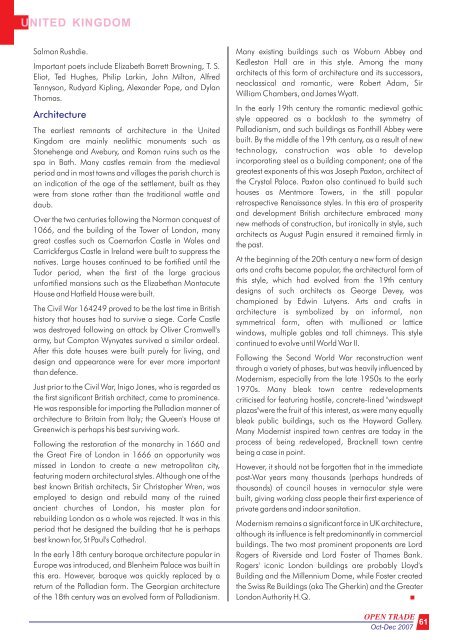pele SciaSction - new media
pele SciaSction - new media
pele SciaSction - new media
Create successful ePaper yourself
Turn your PDF publications into a flip-book with our unique Google optimized e-Paper software.
UNITED KINGDOM<br />
Salman Rushdie.<br />
Important poets include Elizabeth Barrett Browning, T. S.<br />
Eliot, Ted Hughes, Philip Larkin, John Milton, Alfred<br />
Tennyson, Rudyard Kipling, Alexander Pope, and Dylan<br />
Thomas.<br />
Architecture<br />
The earliest remnants of architecture in the United<br />
Kingdom are mainly neolithic monuments such as<br />
Stonehenge and Avebury, and Roman ruins such as the<br />
spa in Bath. Many castles remain from the medieval<br />
period and in most towns and villages the parish church is<br />
an indication of the age of the settlement, built as they<br />
were from stone rather than the traditional wattle and<br />
daub.<br />
Over the two centuries following the Norman conquest of<br />
1066, and the building of the Tower of London, many<br />
great castles such as Caernarfon Castle in Wales and<br />
Carrickfergus Castle in Ireland were built to suppress the<br />
natives. Large houses continued to be fortified until the<br />
Tudor period, when the first of the large gracious<br />
unfortified mansions such as the Elizabethan Montacute<br />
House and Hatfield House were built.<br />
The Civil War 164249 proved to be the last time in British<br />
history that houses had to survive a siege. Corfe Castle<br />
was destroyed following an attack by Oliver Cromwell's<br />
army, but Compton Wynyates survived a similar ordeal.<br />
After this date houses were built purely for living, and<br />
design and appearance were for ever more important<br />
than defence.<br />
Just prior to the Civil War, Inigo Jones, who is regarded as<br />
the first significant British architect, came to prominence.<br />
He was responsible for importing the Palladian manner of<br />
architecture to Britain from Italy; the Queen's House at<br />
Greenwich is perhaps his best surviving work.<br />
Following the restoration of the monarchy in 1660 and<br />
the Great Fire of London in 1666 an opportunity was<br />
missed in London to create a <strong>new</strong> metropolitan city,<br />
featuring modern architectural styles. Although one of the<br />
best known British architects, Sir Christopher Wren, was<br />
employed to design and rebuild many of the ruined<br />
ancient churches of London, his master plan for<br />
rebuilding London as a whole was rejected. It was in this<br />
period that he designed the building that he is perhaps<br />
best known for, St Paul's Cathedral.<br />
In the early 18th century baroque architecture popular in<br />
Europe was introduced, and Blenheim Palace was built in<br />
this era. However, baroque was quickly replaced by a<br />
return of the Palladian form. The Georgian architecture<br />
of the 18th century was an evolved form of Palladianism.<br />
Many existing buildings such as Woburn Abbey and<br />
Kedleston Hall are in this style. Among the many<br />
architects of this form of architecture and its successors,<br />
neoclassical and romantic, were Robert Adam, Sir<br />
William Chambers, and James Wyatt.<br />
In the early 19th century the romantic medieval gothic<br />
style appeared as a backlash to the symmetry of<br />
Palladianism, and such buildings as Fonthill Abbey were<br />
built. By the middle of the 19th century, as a result of <strong>new</strong><br />
technology, construction was able to develop<br />
incorporating steel as a building component; one of the<br />
greatest exponents of this was Joseph Paxton, architect of<br />
the Crystal Palace. Paxton also continued to build such<br />
houses as Mentmore Towers, in the still popular<br />
retrospective Renaissance styles. In this era of prosperity<br />
and development British architecture embraced many<br />
<strong>new</strong> methods of construction, but ironically in style, such<br />
architects as August Pugin ensured it remained firmly in<br />
the past.<br />
At the beginning of the 20th century a <strong>new</strong> form of design<br />
arts and crafts became popular, the architectural form of<br />
this style, which had evolved from the 19th century<br />
designs of such architects as George Devey, was<br />
championed by Edwin Lutyens. Arts and crafts in<br />
architecture is symbolized by an informal, non<br />
symmetrical form, often with mullioned or lattice<br />
windows, multiple gables and tall chimneys. This style<br />
continued to evolve until World War II.<br />
Following the Second World War reconstruction went<br />
through a variety of phases, but was heavily influenced by<br />
Modernism, especially from the late 1950s to the early<br />
1970s. Many bleak town centre redevelopments<br />
criticised for featuring hostile, concrete-lined "windswept<br />
plazas"were the fruit of this interest, as were many equally<br />
bleak public buildings, such as the Hayward Gallery.<br />
Many Modernist inspired town centres are today in the<br />
process of being redeveloped, Bracknell town centre<br />
being a case in point.<br />
However, it should not be forgotten that in the im<strong>media</strong>te<br />
post-War years many thousands (perhaps hundreds of<br />
thousands) of council houses in vernacular style were<br />
built, giving working class people their first experience of<br />
private gardens and indoor sanitation.<br />
Modernism remains a significant force in UK architecture,<br />
although its influence is felt predominantly in commercial<br />
buildings. The two most prominent proponents are Lord<br />
Rogers of Riverside and Lord Foster of Thames Bank.<br />
Rogers' iconic London buildings are probably Lloyd's<br />
Building and the Millennium Dome, while Foster created<br />
the Swiss Re Buildings (aka The Gherkin) and the Greater<br />
London Authority H.Q.<br />
<br />
OPEN TRADE 61<br />
Oct-Dec 2007

















